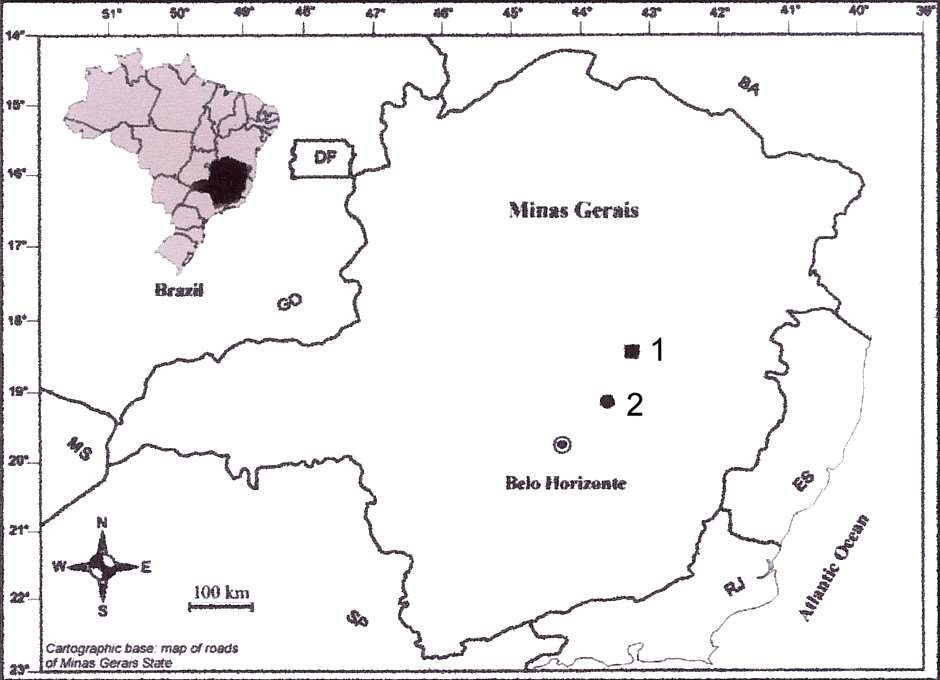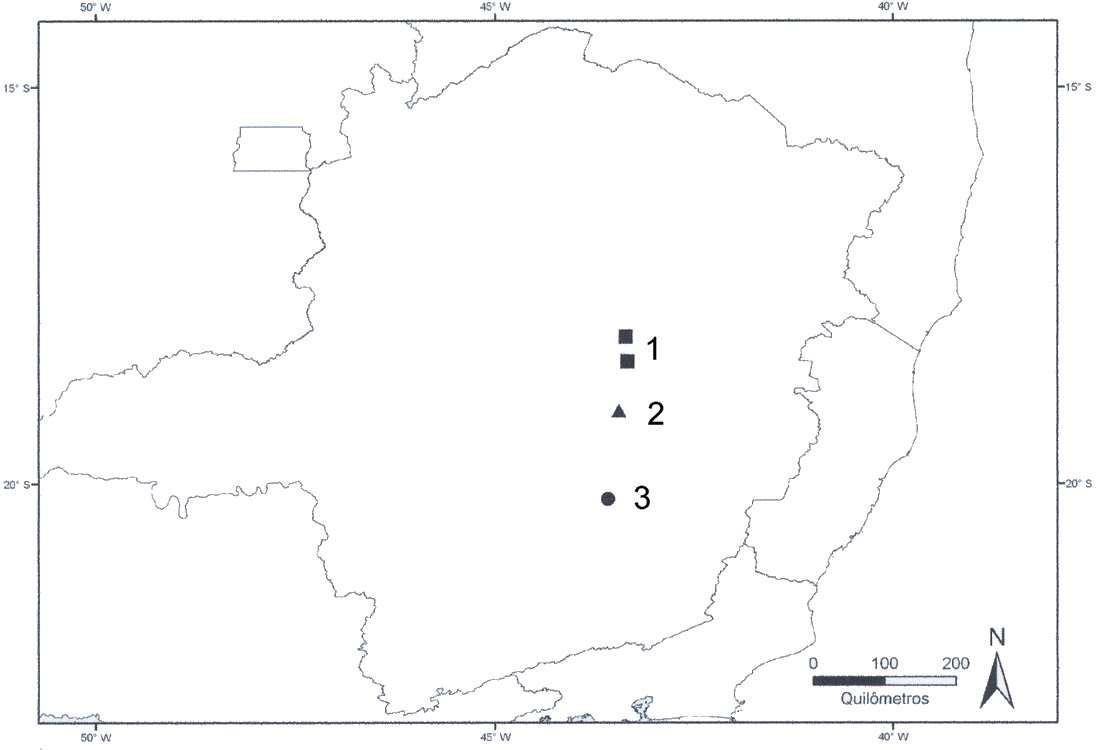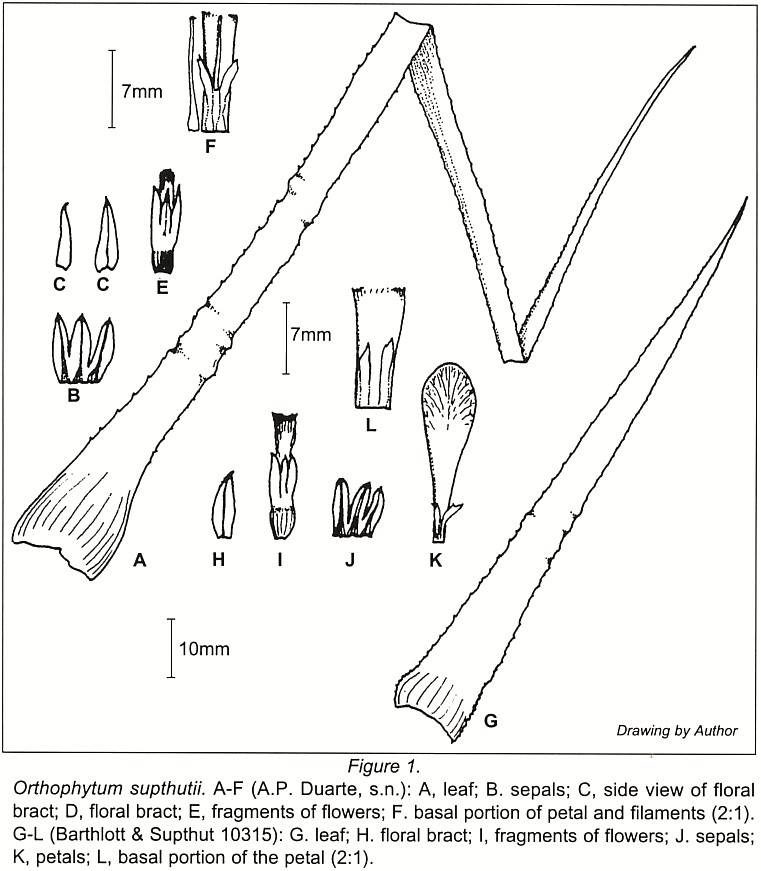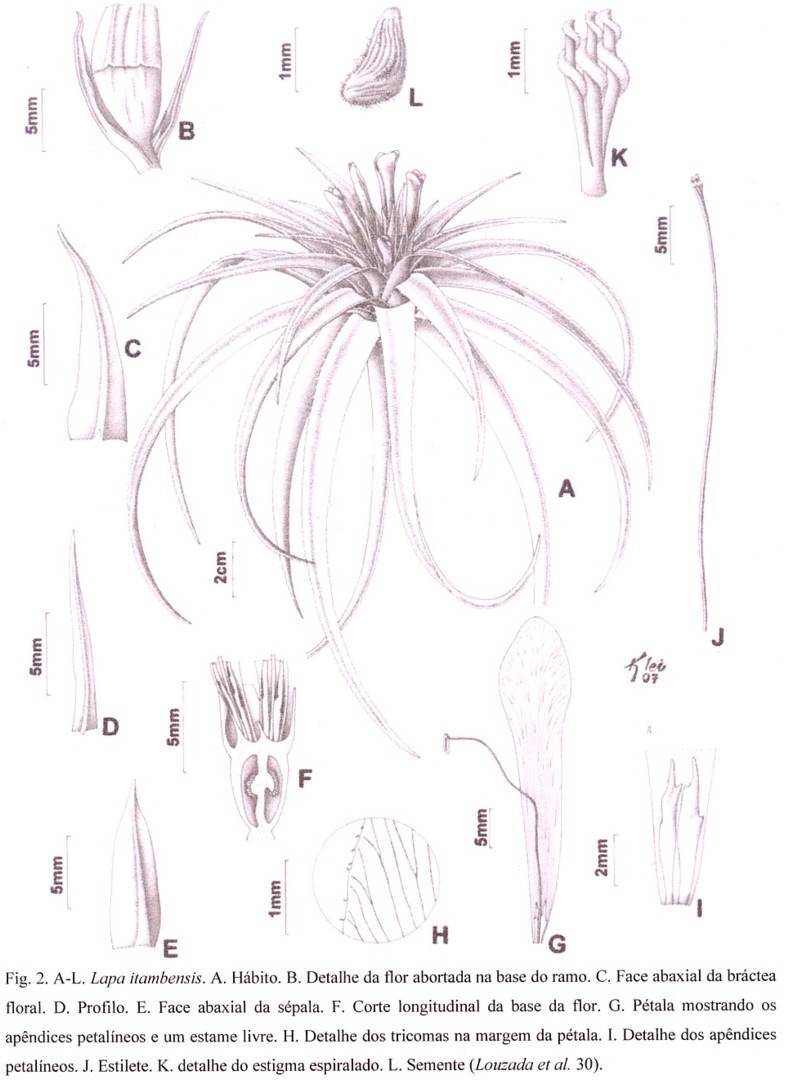






Systematic Botany 35(3): 497-503. 2010.
Lapanthus (Bromeliaceae, Bromelioideae): A new Genus from the Southern Espinhaco Range, Brazil.
by Rafael B. Louzada and Leonardo M. Versieux
Abstract - In this paper we describe a new genus of Bromeliaceae, Lapanthus, restricted to the southem portion of the Espinhaco Range, Minas Gerais State, in southeastern Brazil. Two new combinations to accommodate species previously described in the genera Orthophytum and Cryptanthus and one new synonym are proposed. Lapanthus has morphological affinities with both Cryptanthus, and Orthophytum, but nevertheless differs by the combination of margins of the petals ciliate, presence of lanceolate petal appendages and free stamens, and also by molecular data. Cryptanthus and Orthophytum have petals entire along the margins, and the filaments of the most internal whorl are adnate to the petals. Lapanthus stands out by having a pair of lanceolate petal appendages, which are almost completely adnate to the petals. In Orthophytum, however, appendages are cupuliform or sacriform and they are totally absent in the genus Cryptanthus. Lapanthus and Orthophytum present meiotic and mitotic chromosome numbers equal to n=25 and 2n=50, 100 and 150 respectively, while Cryptanthus presents meiotic and mitotic chromosome numbers n=17 and 2n=34, 36, 54 respectively, and this difference is considered to be an autapomorphic feature of Cryptanthus. Descriptions of the genus and species, identification keys, illustrations, photographs of living specimens, and taxonomic comments are provided.
Bromeliaceae are almost exclusively Neotropical, except for a single species - Pitcairnia feliciana (Harms) Mildbraed, that occurs in western Africa, in Guinea (Smith and Downs 1974). According to Luther (2005), the family comprises 3,085 species in 57 genera. Bromelioideae is the most diverse subfamily in terms of number of genera and is represented in Brazil by at least 21 genera, several of them endemic to the Atlantic Forest of eastern Brazil, which is the center of diversity for this subfamily (Smith 1955; Smith and Downs 1979). The Serra do Espinhaco (Espinhaco Range) extends for ca. 1,100 km from Chapada Diamantina in Bahia state to central Minas Gerais (Harley 1995).
A particular vegetation type known as campo rupestre (rocky field) is characteristic of the more elevated areas (above 900 m) along the Serra do Espinhaco and is recognized as a center of endemism for several plant families (Giulietti et al. 1987; Pirani and Giulietti 1988; Harley 1995; Giulietti et al. 1997). The Serra do Espinhaco exhibits a mosaic of vegetation formations with extensive ecotonal areas, which has allowed the development of a rich Bromeliaceae flora, and is considered the most important endemism area for this family, sheltering 62% of all the endemic bromeliads of Minas Gerais (Versieux and Wendt 2006, 2007; Versieux 2008; Versieux et al. 2008).
During our taxonomic revision of Orthophytum, two species attracted attention due to their unique morphological traits. After investigating the unusual combination of characters presented by these two taxa, we concluded that Orthophytum itambense Versieux & Leme and Orthophytum supthutii (synonym of Cryptanthus duartei) would be better accommodated in a new genus, Lapanthus, which is apparently restricted to the southern portion of the Serra do Espinhaco, in Minas Gerais.
Our taxonomic decision to segregate these taxa was supported by a recent molecular phylogeny of Bromelioideae (Schulte et al. 2009), where Lapanthus appears sister to a clade with both Cryptanthus and Orthophytum, indicating that Orthophytum s. l. (including Lapanthus) is paraphyletic.
TAXONOMIC TREATMENT
Lapanthus Louzada & Versieux, gen. nov. - TYPE: Lapanthus duartei (L. B. Sm.) Louzada & Versieux.
Herbae rupestres, stoloniferae, caule inconspico. Folia rosula, arcuata. Vagina viridis, ovata, glabra, margines serrulatae. Lamina subcoriacea, triangularis ad anguste triangularem, margines serrulatae, apex acutus, apiculatus vel mucronatus. Inflorescentia sessilis, composita ad pseudo-simplicem, 2-floribus ramo. Bracteae primariae foliaceae. Bracteae florales albae ellipticae ad triangulares, glabrae ad sparse lepidotae. Flores corollae tubulari. Sepala alba, elliptica ad triangulares, inconspicua, ca. l/3 petalorum longitudinis. Petala libera, alba vel aurantiaca, spathulata, margines ciliatae, lobus leviter reflexus, apex obtusus. Appendices petalorum lanceolata. Tubus epigynicus nullus. Stamina libera, antheris linearibus. Stylus 3-costatus. Pollen 1-colpatum. Ovarium trigonum placentatione axiali. Semina striata.
Herbs rupicolous, stoloniferous, stem an inconspicuous rhizome, covered by the leaf sheaths. Leaves rosulate, arcuate. Leaf sheath green, ovate, glabrous, margins serrulate. Leaf blade subcoriaceous, triangular to narrowly triangular, margins serrulate, apex acute apiculate or mucronulate. Inflorescence sessile, compound with two flowers per branch or pseudosimple (i.e. branches with 1 fertile and 1 aborted flower). Primary bracts foliaceous, green or reddish-green at anthesis. Floral bracts white-hyaline, triangular, glabrous to sparsely tepidote. Flowers with a tubular corolla. Sepals white-hyaline, elliptic to triangular, inconspicuous, reaching ca. l/3 of the flower length.
Petals free, white-hyaline or orange-yellow, spatulate, apex obtuse, lobe slightly reflexed, margins ciliate, bearing two lanceolate petal appendages almost completely connate to the petal. Epigynous tube absent. Stamens free, filaments filiform, anthers linear. Style tricostate. Pollen grain monocolpate with reticulate exine. Ovary trilocular, pluriovulate, placentation axile, subapical. Seeds striate, pilose. Figures 1-4.
Etymology - The genus honors Dr. Maria das Gracas Lapa Wanderley, botanist from Instituto de Botanica, Sao Paulo, who has instructed several generations of Bromeliaceae specialists and has greatly contributed to our floristic knowledge of Sao Paulo and Minas Gerais States. As a secondary meaning, it also refers to the rocky substrate where these plants grow, since lapa is a word in Portuguese for rocky shelters similar to the habitat of both species.
Identification key for Lapanthus and allied genera
1. Petals with a pair of appendages at the base. => 2
- 2. Petals with reflexed lobes; petal appendages sacciform or cupuliform; stamens from the intemal whorl adnate to the petals => Orthophytum
- 2. Petals with straight lobes; petal appendages lanceolate; stamens from the intemal whorl free => Lapanthus
1. Petals without appendages => Cryptanthus
Lapanthus duartei (L. B. Sm.) Louzada & Versieux comb. nov.
Cryptanthus duartei L. B. Sm., Smithson. Misc. Collect. 126: 23. 1955.-TYPE: BRASIL. Minas Gerais: Serra do Cipo {fl}, Nov 1949, Duarte s. n. (holotype: US!; isotype: RB!)
Orthophytum supthutii E. Gross & Barthlott. Trop. Subtrop. Pflanzen. 15: 46. 1990.-TYPE: BRAZIL. Minas Gerais: {fl}, Fev 1988., Barthlott & Supthut 70315 (holotype: HB!; isotype: HEID). syn. nov.
Herbs rupicolous, stoloniferous;
stem ca. 1-2 x 0.7-1 cm, short.
Leaves 5.5-25 cm long, numerous, arcuate;
leaf sheath 0.8-1.8 x 0.8-1.8 cm, green, ovate, abaxial surface lepidote, adaxial surface glabrous and lustrous, margins serrulate, prickles 0.1-0.5(-1) mm, minute;
leaf blade 5-22.5 x 0.8-1 cm, subcoriaceous, green, linear-triangular to narrowly triangular, glabrescent adaxially, densely lepidote abaxially, margins serrulate, prickles 0.3-0.6 mm, antrorse, apex acute, mucronulate.
Inflorescence compound, near 6-10(-30) flowered, primary bracts foliaceous, green, narrowly triangular, margins spinose, acute apex.
Floral bracts 1-1.3 x 0.25-0.5 cm, membranaceous, white, asymmetric, carinate, triangular margins serrulate toward the apex, apex lepidote, acute, uncinate.
Sepals 0.8-1.2 x 0.4-0.5 cm, white, asymmetric, carinate, connate, triangular, sparsely to densely lepidote toward the apex, margins entire, apex acute.
Petals 2.8-3.8 x 0.8-1.4 cm, whitish-orange at base to orange-yellow toward the apex spatulate, apex obtuse, petal appendages 0.5-1 cm, free for 0.1-0.5 cm.
Filaments of the first whorl 2.3-3.1x 0.4 cm, the ones from the second whorl 2.6-3.4 x 0.6 cm, filiform, anther 1.6-2 mm, linear, apex apiculate.
Ovary ca. 0.5 x 0.4 cm, white, ovules ca. 30 per locule, hyaline, style 3.2-4 cm, stigma lobes ca. 2 mm, weakly spreading at anthesis.
Fruit and seed not seen.
Distribution - The species is known from relatively few records, all of them from areas of transitional vegetation between semideciduous seasonal forest and campo rupestre in the Serra do Cipo area. At present two populations are known from Conceicao do Mato Dentro County growing on humid quartzitic rock outcrops near semideciduous seasonal forest at 646 m altitude.
Etymology - The epithet honors the late botanist Apparicio P. Duarte, from Jardim Botanico do Rio de Janeiro (RB), who collected the type.
Additional Specimens Examined - BRAZIL. Minas Gerais. Mun. Conceicao do Mato Dentro, {fl}, Hatschbach 35400 (MBM, US); Serra do Cipo, 9 Oct 2006 {fl}, Louzada et al. 28 (SP). Santana do Riacho, {fl}, 30 Mar 1980, Menezes 941(SPF).
Lapanthus itambensis (Versieux & Leme) Louzada & Versieux, comb. nov. Orthophytum itambense Versieux & Leme, Novon 17(1): 130-134. 2007.-TYPE: BRASIL, Minas Gerais: Santo Antonio do Itambe, Parque Estadual do Pico do Itambe, proximo a cachoeira da Fumaca, ca. 850 m, 29 Ago 2003, {fl} Versieux & Faria 149 (holotype: HB!; isotypes: BHCB!, RFA!, SEL!, SP!).
Herbs rupicolous, stoloniferous, stem ca. 1.5 x 15 cm; short. leaves 11-34.5 cm, numerous, arcuate; leaf sheath 1.5-1.8 x 1 cm, whitish-green, ovate, glabrous in both surfaces, margins serrulate, prickles 0.1-1 mm, minute; leaf blade 9-32.5 x 0.7-1. cm, subcoriaceous, pale green, linear-triangular to narrowly triangular, lepidote in both faces, white cross band of trichomes adaxially, margins serrulate, prickles 0.5-1.5 mm, straight or antrorse near the apex, apex acute to mucronulate. Inflorescence pseudo-simple (i.e. branches with 1 fertile and 1 aborted flower), 10-20 flowered, branches concealed by one bracteole at the base of the functional flower; primary bracts 5.5 x 0.8 cm, foliaceous, reddish green or green, narrowly triangular, margins serrulate, base with entire margin, apex acute. Floral bracts c. 1.1 x 0.3 cm, membranaceous, white, laterally asymmetric, carinate, triangular, glabrous, margins entire, apex acute. Sepals 1.2 x 0.3 cm, white, asymmetric, carinate, free or nearly so, elliptic, sparsely lepidote toward the apex, margins entire, apex acute. Petals ca 4.l x 1 cm, white, spatulate, apex obtuse, petal appendages 0.8-1 cm, free portion 2.5-4 mm, margins irregular, apex acute, entire or bifid. Filaments white, first whorl ca. 2.5 cm, the ones from the second whorl ca. 3.5 cm anthers 2.9-3.4 mm oblong, dorsifixed in the base, apex apiculate. Ovary white with ca. 30 ovules per locule, style 3.7 cm, stigma lobes free at anthesis. Fruit tri-winged, seeds ca. 1.5 mm, numerous, pilose, rugose, yellowish-brown when fresh, brown when dry.
Distribution - The species is only known from the Municipio of Santo Antonio do ltambe, where it occurs inside of Parque Estadual do Pico do ltambe in humid quartizitic rock outcrops near to waterfalls and gallery forest, between 700--900 m.
Etymology - Refers to the type locality: the Municipio of Santo Antonio do Itambe, and the Parque Estadual do Pico do Itambe, at Minas Gerais State.
Additional Specimens Examined - BRAZIL Minas Gerais: Municipio de Santo Antonio do Itambe, Parque Estadual do Pico do Itambe, 15 Dec 2005 {fr} Louzada et al. 6 (SP); 10 Oct 2006 {fr}, Louzada et al. 30 (SP); 10 Oct 2006 {fr}. Versieux et al. 302 MO, SEL, SPF).
Identification key for the species of Lapanthus
1. Inflorescence compound; sepals high connate; Petals orange-yellow => duartei
1. Inflorescence pseudosimple sepals free or nearly so; petals white => itambensis
Discussion
Lapanthus duartei and L. itambensis can be separated by the colour of the primary bracts (green vs. red) and petals (white vs. orange-yellow), and inflorescence pattern (compound vs. pseudo-simple). Additionally the size of floral structures is also quite distinct in L. duartei the sepals are smaller 0.8-1.2 cm and connate while in L. itambensis the sepals are free and never shorter than 1.2 cm. Also, anatomical features are useful to separate the two species, as shown by Versieux and Leme (2007).
Smith (1955) described Cryptanthus duartei from a collection of Appaicio Duarte s. n. (RB 76607) from November 1949, at the Serra do Cipo. For several years this taxon was considered intriguing because it was the only species within the genus Cryptanthus with orange petals. In 1990, Harry Luther examined the holotype of C. duartei housed at the US National Herbarium and observed the presence of a pair of petal appendages in the flowers, a key character that segregates Cryptanthus from Orthophytum. Although Luther added a determination tag and a schematic drawing to the holotype indicating that Cryptanthus duartei should be transferred to Orthophytum, the new combination was not made, firstly because the name Orthophytum duartei had already been published for a different species also collected by Apparicio Duarte, and secondly because Cryptanthus duartei was a synonym of an orange-flowered Orthophytum described from Serra do Cipo, Orthophytum supthutii E. Gross & Barthlott, as is clearly indicated on the holotype by a second determination tag also added by Harry Luther in 1994. The same conclusions regarding the identity of this taxon as those indicated by Luther on the holotype were published by Leme (1995). The orange-yellow petals of O. supthutii, with no obviously closely related taxon within the genus, also intrigued Gross and Barthlott (1990) who suggested that a new subgenus should be created for this species.
Versieux and Leme (2007) described one new Orthophytum species (O. itambense), considering it closely related to O. supthutii. Orthophytum itambense has white flowers and the leaves usually exhibit white cross-bands of trichomes. However the presence of free stamens and a tubular corolla, as well as the habit and habitat, indicate the proximity between O. itambense and O. supthutii setting them in an isolated position within the genus.
In the systematic revision of the species of Orthophytum with sessile inflorescences conducted by Louzada (2008), special attention was given to Lapanthus duartei and L. itambensis, due to the presence of characters apparently contradictory to current circumscriptions of both Orthophytum and Cryptanthus. As exclusive characters that were observed in the habitat and confirmed by our detailed morphological analysis we list the ciliate margins of petals (Figs. lH,2H), presence of lanceolate petal appendages (Fig. 1G, 2I), and free stamens. This combination of characters distinguishes L. duartei and L. itambensis from both genera Orthophytum and Cryptanthus. Other characters segregating these taxa are summarized in Table 1. Also, a recent molecular phylogeny based on plastid and nuclear loci done by Schulte et al. (2009) shows L. duartei (treated as Orthophytum supthutii as an independent lineage from the remainder of Orthophytum, which appears sister to Cryptanthus. This analysis indicates that Orthophytum, as traditionally circumscribed, is a paraphyletic group. The new genus described here was provisionally called Lapa in the first author's M. S. thesis (Louzada 2008). However, to avoid problems of homonymy with Lappa (Asteraceae) we now effectively publish it as Lapanthus.
Petal appendages, which have been broadly used in the generic classification of Bromeliaceae, are quite distinctive among these taxa as well. Species of Orthophytum possess sacciform or cupuliform appendages with lacerate margins while in Lapanthus duartei and L. itambensis the appendages are lanceolate and almost completely adnate to the petal except for the free apical portion. Nevertheless, the presence or absence of petal appendages has been considered problematic as a taxonomic character for genus delimitation in Bromeliaceae because they are the last structure to be formed on the petal, being susceptible to loss or modifications (Brown and Terry 1992). Here, the taxonomic importance of the petal appendages is highlighted not only by their presence but also due to their distinct morphology among taxa.
Difficulties in delimiting genera within Bromelioideae are broadly cited and as emphasized by Lyman Smith in the preface of his monumental work (Smith and Downs 1979), that is still the most up to date monograph on the subfamily, "The Bromelioideae are a step worse in that their genera are so poorly defined that even with complete information it is difficult to assign some species to genera". So, considerable systematic and nomenclatural changes are to be expected after new molecular phylogenies or the observation from fresh material of morphological characters that are difficult to examine in herbarium material. We consider it more appropriate to describe a genus rather than a subgenus within Orthophytum, as suggested by Gross and Barthlott (1990), because according to the topologies presented by Schulte et al. (2009) Lapanthus (then represented by Orthophytum supthutii) is the sister group of the clade Orthophytum-Cryptanthus (Lapanthus (Orthophytum, Cryptanthus)). Thus the inclusion of Lapanthus as a subgenus of Orthophytum as suggested by Gross and Barthlott (1990) would not make the latter genus monophyletic. An alternative to the description of the new genus would be to merge the three genera (i.e. Cryptanthus, Lapanthus and Orthophytum) in a single genus Cryptanthus, which is the oldest name, including Orthophytum and Lapanthus as monophyletic sub-genera. Nevertheless, this broadly circumscribed Cryptanthus would not be feasible because it would encompass too much variation in morphological, reproductive, karyotypic and distributional characters, not providing one easily observable morphological trait to distinguish it. Although these genera show common morphological characteristics (Table 1), they have sufficient differences to justify their segregation. Our decision to describe the new genus is also based on a large scale morphological analysis and taxonomic revision of all species of Orthophytum carried out by the first author. Additionally, examination of 15 living specimens of 10 species of Cryptanthus and a review of the main literature regarding the latter genus (Smith and Downs 1979; Ramirez-Morillo 1996) served as the basis for comparisons and emphasized the uniqueness of the new taxon.
The chromosome number is an additional character that aids in our taxonomic decision to consider this new genus different from Cryptanthus. Louzada et al. (2010) present counts of chromosome numbers for twelve species of Orthophytum, including Lapanthus duartei. These species exhibit meiotic and mitotic chromosome numbers n=25 and 2n=50, 100 and 150, results that are consistent with the proposed basic number of x=25 for Bromeliaceae (Marchant 1967) but differ from Cryptanthus, whose reported chromosome numbers n=17 and 2n=34, 36, 54 (Lindshau 1933; Sharma and Ghosh 1971; Brown and Gilmartin 1986; Bellintani et al. 2005) are considered autapomorphic for the genus (Ramirez-Morillo and Brown 2001).
Identification key for the species of Lapanthus
la Inflorescence compound, sepals high connate => duartei
lb Inflorescence simple or pseudo-simple, sepals free or nearly so => 2
2a Inflorescence simple, petals greenish-yellow, petal appendages obdeltoid => vidaliorum
2b Inflorescence pseudo-simple, petals white, petal appendages lanceolate => itambensis